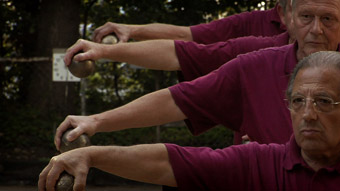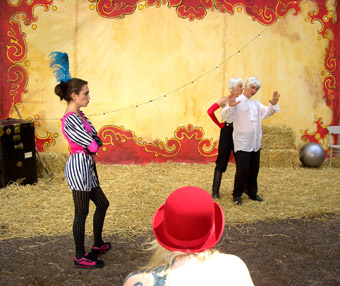reframing the dance screen
chirstinn whyte: dance for camera, brighton, uk

La Boule d’Or
photo Mario del Curto and Marc Perroud
La Boule d’Or
ALL FESTIVALS ARE ESSENTIALLY WORKS IN PROGRESS, WITH NEW DIRECTIONS AND DEVELOPMENTS EVOLVING AND ADAPTING FROM YEAR TO YEAR. NOW IN ITS ELEVENTH INCARNATION, DANCE FOR CAMERA, RUN BY SOUTH EAST DANCE AND SCREENED UNDER THE UMBRELLA OF BRIGHTON’S CINECITY, IS THE LONGEST ESTABLISHED OF THE BRITISH SCREENDANCE CIRCUIT, WITH NEW INITIATIVES THIS YEAR SIGNALLING A SHIFT BEYOND THE REMIT OF TRADITIONAL PROGRAMMING.
Proceedings began with Screendance Expanded, a one-day symposium, jointly organised by University of Brighton, providing a gathering point for the otherwise geographically scattered screendance community, and attracting an internationally representative mix of students, artists and academics. Following keynote speeches from Vena Ramphal and Sarah Wood, sessional focus shifted between funding, providing for youth and distribution, with a discussion forum highlighting the currently narrow range of opportunities—including Birminghan-based Dance TV and BBC commissioning—for televised and cinema-based screening. A workshop on future trends underlined the importance of advocacy and artist-led curation, with former BBC producer Bob Lockyer emphasising the need for bridge-building between contemporary production models. In addition, a panel exploring modes of discourse included visual arts writer Sally O’Reilly and dance critic Donald Hutera, foregrounding the potential of critically-led cross-pollination for a genre hindered by lack of specialist writing.
Within festival scheduling, sell-out status required an immediate repeat screening for a newly introduced, experimentally oriented program of predominantly short, single mood works. These included Christina Von Greve and C-Schulz’s intensely-focused abstraction of intermittent light sources in the monochromatic Flicker (2006); Phil Harder, Rosanne Chamecki and Andrea Lerner’s pleasingly fanciful use of stop frame animation in Flying Lessons (2007); Yves Ackermann’s deconstruction of shoot-em-up mores in Prototype (2007); and the opulent spectacle of Shelly Love’s The Forgotten Circus (2008). A complementary program of work in longer form featured Danièle Wilmouth’s A Heretic’s Primer on Love & Exertion: 29 Incidents of Dual Consequence (2007). Here, a highly-coloured picaresque world evolved from recurrent episodes of poker-faced text and task-based playfulness, with a movement vocabulary of clicks, swings, hops and jumps, linked and punctuated by a deftly rhythmic grammar of camera motion.

Heretic’s Primer
Also new to the festival, a quartet of documentary influenced work, selected from open call, uncovered a range of understatedly effective screen conceptualisations. Film editor Walter Murch has described the process of editing as “a kind of frozen dance” and Jonathan Perel’s 5 (Cinquo) (2008) skilfully utilised the potential of the kinetic bridge by intercutting between separately filmed versions of the same studio-set sequence. Bruno Deville and Philip Saire’s La Boule d’Or (2008) combined talking head interview with quietly assured camera positioning, alternating overhead and point of view shots as Saire coached four impassive, middle-aged boules players through stylised still positioning and elegantly composed walking patterns. Dirk Hilbert and Kasturi Mishra located the visual richness of Kathak-based studio footage within a contemporary Indian, city-based cultural context in Krishna’s Dancer (2006), while Gideon Obarzanek and Edwina Throsby’s Dance Like Your Old Man (2007) set voice over against front-on framing, as a series of young women inhabited the movement patterning and stylistic tics of their fathers’ social dancing styles, gently illuminating the complex blend of amusement, irritation and affection of one generation for another.
The first of two programs exploring non-traditional curation showcased work created in partnership with, and selected by, adults with learning disabilities. From Oska Bright, Oliver Turnbull, Miriam King and Simon Wilkinson’s The Man in The Hat (2007) reversed the workings of time and gravity as a single male figure negotiated an ambiguous, grey-scaled landscape of leaves and sky in a strikingly effective use of retrograde motion.
Meanwhile Fresh Takes—a parallel program selected by Youth Jury—drew attention to the intense physicality of the young male experience and to the integration of movement and location. Film theorist Siegfried Kracauer believed that screen-based dance should arise from context “as part and parcel of physical reality”, and in Craig Viveiros’ Stereo Step (2006), an apparently continuous Michel Gondryesque follow shot tracked street and social dance tropes through a densely populated series of exterior and interior spaces, additionally highlighting camera journey as choreographic device.
In a significant example of inter-genre lineage, a through-line was clearly traceable from Peter Anderson and Rosemary Lee’s physical and psychic interrelation of protagonist and surroundings in boy (1995) to Sergio Cruz’ visually sophisticated blending of still image and point of view shot in Animalz (2006), which imagined into being a natural context for the heightened physicality of pre-teen b-boys. Evoking the fluidity of adolescent identity, both works inhabit a liminal, shore-set landscape of scrub, sand and waves, with the “ramifications of the moment” layered into a poetically-oriented, non-linear mesh of elements and imagery, as outlined in Maya Deren’s notion of vertical narrative progression.
Of particular significance, an expanded program of installations sited in and around the Lighthouse building moved viewing engagement beyond a sit-down, front-on, single screen model. Work ranged in scope from mobile-phone-created, one-minute pieces to Jeremy Radvan’s digitised chalk-and-slate-style reinvention of Victorian visual forms in MyrioRama (2008), and Billy Cowie’s continuing experimentation with 3D imagery in The Revery Alone (2008). Here, in contrast to the highly realised environment integral to In the Flesh (2007), the traditional signifiers of performance—music, codified movement, costume—were stripped away, confronting the floor-bound viewer with their own response to the life-sized, hologramatic image of a naked female figure, suspended from four ceiling-fixed hand and foot grips, and silently shifting through gymnastic contortion in an uneasy exploration of the power dynamic central to the interchange of gaze.
Elsewhere, the highly polished visual stylisation of the Quay Brothers, shown as part of Cinecity programming in Eurydice—She, So Beloved (2007), combined large scale screen-based images with peephole-glimpsed miniaturised models, housed within a coffin shaped interior.
Luke McKernan has observed that the origins of cinema are tied to “the study of motion”, and new initiatives at Dance For Camera held up a mirror to the range of territory currently opening to pioneering artists and audiences within contemporary models of production; curation; presentation and discourse in an ever-expanding range of 21st century potentiality.
–
Dance For Camera, Brighton, UK, Dec 5-7, 2008; www.southeastdance.org.uk/danceforcamera2008
RealTime issue #89 Feb-March 2009 pg. 26






